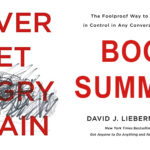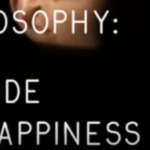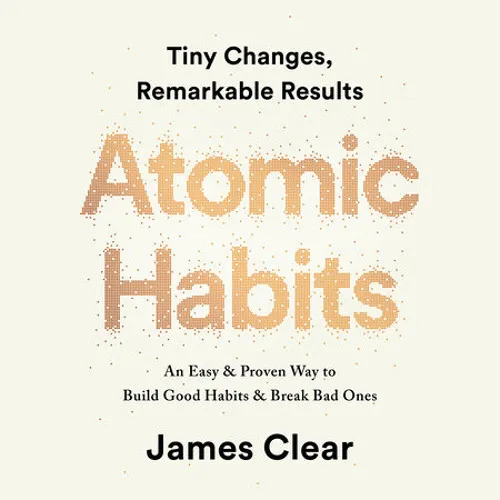
Atomic Habits – James Clear (Summary)
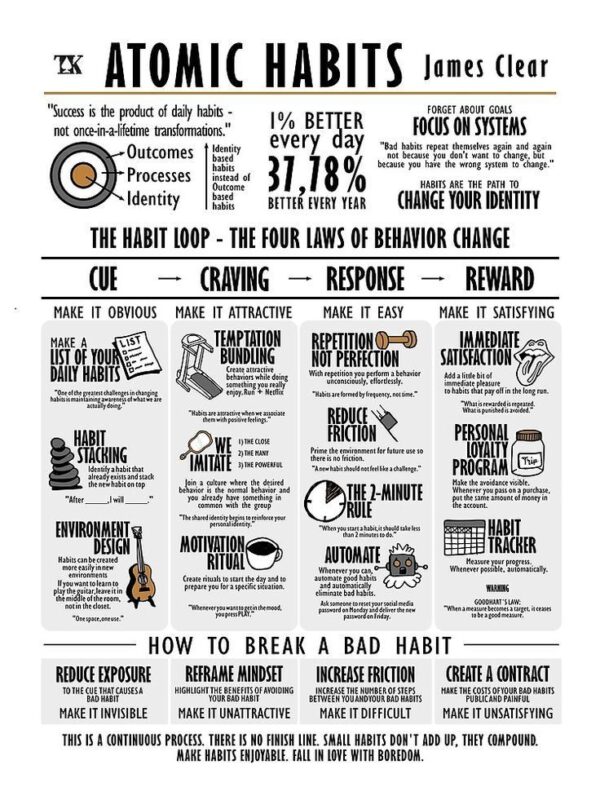
An easy and proven way to build good habits and break bad ones. Tiny changes, remarkable results.
Lots of stories and experiments.
Set goals, use systems and focus on systems getting better each day. So once you know your goal don’t focus on it and start working on the system making it better.
3 Changes (Habits shape your identity – and we make the mistake of first trying to change the wrong thing and try to change it in the wrong way.)
1. Change your outcomes;
2. Change your process;
3. Change your identity.
So you need to focus on who you want to become and change your identity for example instead of saying I’m trying to quit smoking you say I don’t smoke. Once you take pride in your change and identity your will do it more and more enthusiastically. Big issue is identity conflict when your group identity is different to the identity you want to achieve.
2 Steps to Change your Identity
1. Decide the type of person you want to be. Whatever you do everyday is what you become. Every action you take is a vote for the type of person you want to become. Start from who you want to be and work backwards to know what steps you need to take.
2. Prove it to yourself with small wins.
“Behaviors followed by satisfying consequences tend to be repeated and those that produce unpleasant consequences are less likely to be repeated.”
Edward Thorndike
Science of Habits – 1 Cue > 2 Craving > 3 Response > 4 Reward (More info on this habit loop here – The Power of Habit

The 4 Laws of Behaviour Change
– How to Create a Good Habit
The 1st law (Cue): Make it obvious.
The 2nd law (Craving): Make it attractive.
The 3rd law (Response): Make it easy.
The 4th law (Reward): Make it satisfying.
We can invert these laws to learn how to break a bad habit.
– How to Break a Bad Habit
Inversion of the 1st law (Cue): Make it invisible.
Inversion of the 2nd law (Craving): Make it unattractive.
Inversion of the 3rd law (Response): Make it difficult.
Inversion of the 4th law (Reward): Make it unsatisfying.
A habit is a behavior that has been repeated enough times to become automatic. The ultimate purpose of habits is to solve the problems of life with as little energy and effort as possible.
Pointing-and-Calling reduces errors by up to 85 percent and cuts accidents by 30 percent. Just obviously pointing at a door closing and shouting that the door is closing. So forgetful people can repeat that they’ve got their keys, wallet, glasses, etc. So make a list of what you do and make them as positive, neutral or bad. You can find a scorecard here – atomichabits.com/scorecard. Ask yourself if each habit casts a vote for who you want to be. You could try speaking out loud the negative consequences of the bad habit you perform.
Write down or calendarise what exactly you are going to do e.g. I’m going to go for a jog every Monday, Wednesday and Friday for 15 minutes during my lunch break and then have my lunch. Best start on the first day of the week. The implementation intention formula is: I will [BEHAVIOR] at [TIME] in [LOCATION].
Habit Stacking
Identify a current habit and stack a new behaviour on top e.g. as soon as I remove my work shoes I will change into my workout clothes. So tie these habits until you have a stack from meditation to gratitude to reading more.
The habit stacking formula is: After [CURRENT HABIT], I will [NEW HABIT]. You can go deeper with your scorecard or get more info here – atomichabits.com/habitstacking
Behavior is a function of the Person in their Environment, or B = f (P,E). Think of impulse buying while you’re paying for your fuel and all the cheap but tempting products are around. It’s easy to not do something if it’s not near you (out of sight out of mind). Increase the odds of doing good habits by obvious cues in your environment. Start going to a new park/shop/etc to start a new routine. You can create one space for one use like activity zones e.g. bed only for sleep, no phones on the dining table. (Paras note: I do this often but it’s not as easy when you have kids and partners who like touching your things and moving them around).
Sometimes you can remove a single cue and that is enough to cut the bad habit.
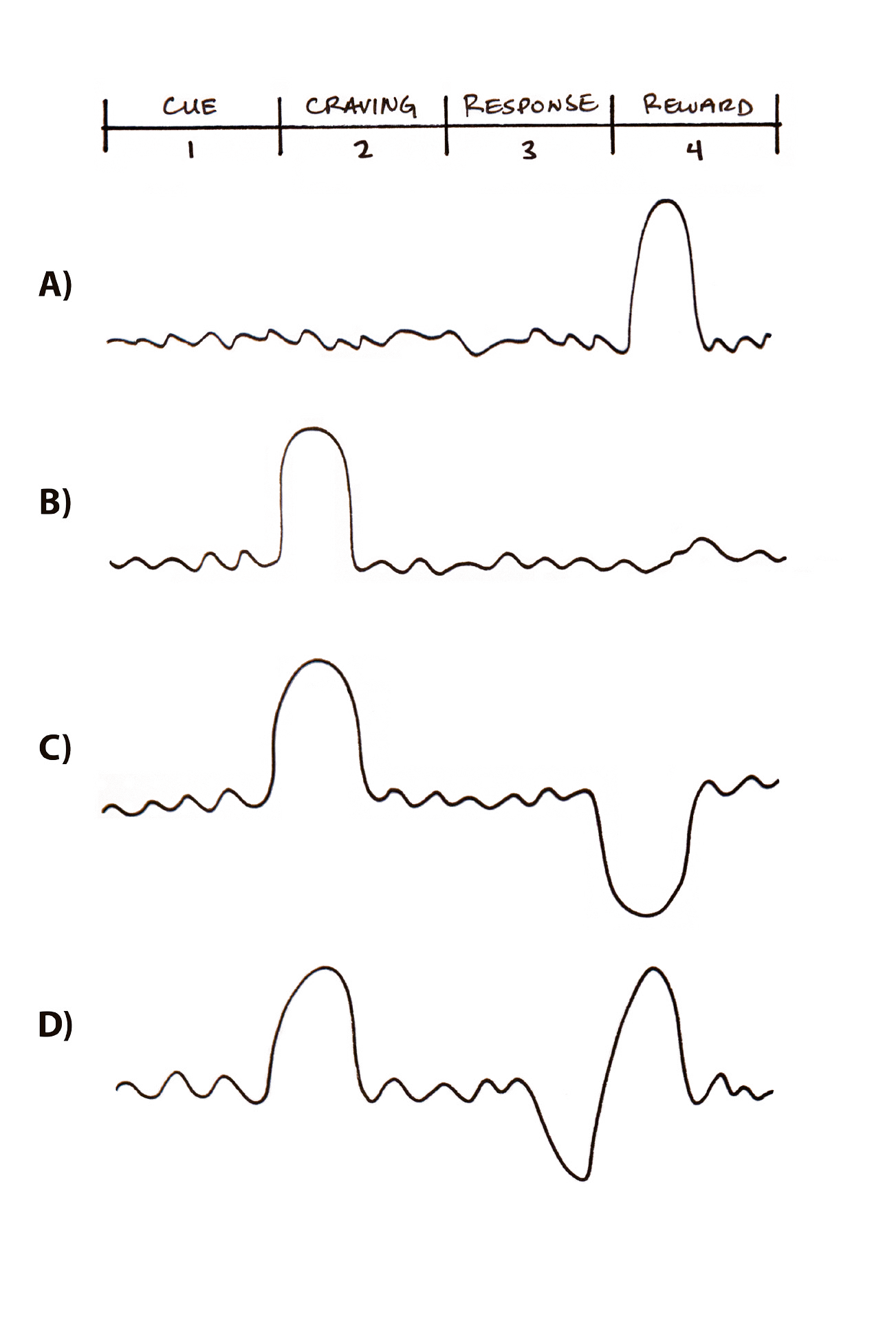
Make it Attractive!
From soft alcohol like beer to hard liquor. From simple makeup to plastic surgery. We want more. Remember the dopamine spike moves to the anticipation of a reward like when an addict see’s cocaine or a gambler before even placing a bet.
Temptation Bundling
Ronan Byrne linked an exercise bike to his laptop so it only ran when he cycled. Only get a pedicure while processing overdue work emails.
The habit stacking + temptation bundling (Premack’s Principle) formula is:
1. After [CURRENT HABIT], I will [HABIT I NEED].
2. After [HABIT I NEED], I will [HABIT I WANT].
E.g.
1. After I pull out my phone, I will do ten burpees (need).
2. After I do ten burpees, I will check Facebook (want).
We imitate the habits of three groups in particular:
1. The close. Join a group or be around people who you want to be like. E.g. You belong to that tribe of cyclist.
2. The many. It’s usually a smart strategy like looking at google/yelp reviews but not when you want to change your habits.
3. The powerful. If you get so good at it you’ll gain power and that respect and praise is attractive.
Highlight the benefits of avoiding a bad habit to make it seem unattractive. Create a motivation ritual by doing something you enjoy immediately before a difficult habit.
The more you repeat an activity the more the structure of your brain changes to become efficient at that activity. Repetition is a form of change so it’s the most critical thing you can do. Think of it as a learning curve, after a certain number of reps it will be come a habit. Make it easy! The amount of time you have been performing a habit is not as important as the number of times you have performed it.
Make it so easy that even on your tough days you can do it. Look for points of friction you can remove. Prime your environment e.g. Want to draw more? Put your pencils, pens, notebooks and drawing tools on top of your desk, within easy reach. Or, only plug your TV back on when you can say the name of the show you want to watch. Redesign your life so the actions that matter most are also the actions that are easiest to do.
Decisive Moments
That first step to get the routine going or the difference between the good choice or the bad choice. Use a two-minute rule (When you start a new habit, it should take less than two minutes to do.) – just read/do yoga/wear running shoes for 2 minutes and build these gateway habits. It’s best to stop straight after the 2 minutes until you’re ready to add more. Master the small steps before taking bigger ones (see more about Progressive Overload)
“The best way is to always stop when you are going good.”
Ernest Hemingway
A commitment device is a choice you make in the present that controls your actions in the future. You can reduce overeating by purchasing food in individual packages rather than in bulk size.
Onetime Actions (Paras note: I picked the ones I already do.)
– Use smaller plates to reduce caloric intake.
– Remove your television from your bedroom.
– Turn off notifications and mute group chats.
– Delete games and social media apps on your phone.
– Buy a supportive chair or standing desk.
– Enroll in an automatic savings plan.
The Cardinal Rule of Behavior Change: What is IMMEDIATELY rewarded is repeated. What is IMMEDIATELY punished is avoided.
It almost always happens that when the immediate consequence is favorable, the later consequences are disastrous, and vice versa. . . . Often, the sweeter the first fruit of a habit, the more bitter are its later fruits.
Frédéric Bastiat
The vital thing in getting a habit to stick is to feel successful. Make it so that you can see your savings for your holiday are going up when you skip that high-calorie daily coffee.
Track your habits (Paras note: Here are some of the things I track – Anger and Smoking)
– Some people move paperclips or marbles from one jar to another for every sales call/book page/push-up/etc.
– Benjamin Franklin carried a small booklet everywhere he went it to track thirteen personal virtues.
– Jerry Seinfeld ‘never broke the chain’ of writing a joke everyday.
– The benefits are that they’re obvious, attractive and satisfying.
– The habit stacking + habit tracking formula is: After [CURRENT HABIT], I will [TRACK MY HABIT].
– Never miss twice. If you miss one day, try to get back on track as quickly as possible.
– Even doing the action, bad joke/workout/habit is still doing it and keeping the habit.
– Remember not to be driven by the number as will end up as Goodhart’s Law “When a measure becomes a target, it ceases to be a good measure.” e.g. looking at the weighing scale everyday.
If you want to prevent bad habits and eliminate unhealthy behaviors, then adding an instant cost to the action is a great way to reduce their odds. The strength of the punishment must match the relative strength of the behavior it is trying to correct.
The Habit Contract
A verbal or written agreement in which you state your commitment to a particular habit and the punishment that will occur if you don’t follow through. Then you find one or two people to act as your accountability partners and sign off on the contract with you.
The secret to maximizing your odds of success is to choose the right field of competition. First look for the answer by understanding your personality. Then find a game where the odds are in your favour (the law of making it easy). Use explore/exploit trade-off. If you’re looking for a relationship then ‘explore’ dating. If you like the person you’re dating then ‘exploit’. So if you don’t find the right person keep exploring. Ask yourself what feels fun, where do you lose track of time, get greater returns, do naturally. Finally remember the more your clarify your genes the better your odds. Tall people have worse odds of being a jockey but better odds of playing basketball.
The Big Five Personality Traits – The most proven scientific analysis breaks them down into five spectrums of behavior.
1. Openness to experience: from curious and inventive on one end to cautious and consistent on the other.
2. Conscientiousness: organized and efficient to easygoing and spontaneous.
3. Extroversion: outgoing and energetic to solitary and reserved (you likely know them as extroverts vs. introverts).
4. Agreeableness: friendly and compassionate to challenging and detached.
5. Neuroticism: anxious and sensitive to confident, calm, and stable.
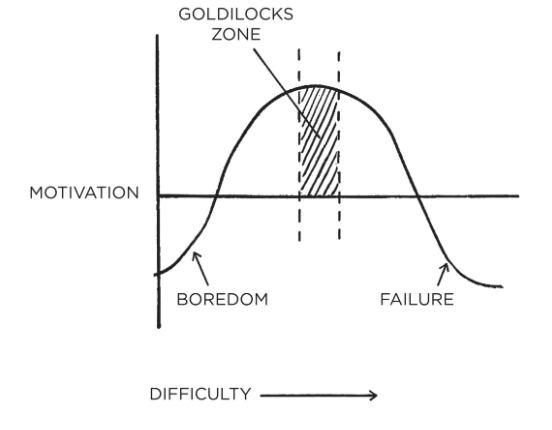
The Goldilocks Rule
Humans experience peak motivation when working on tasks that are right on the edge of their current abilities. Not too hard. Not too easy. Just right.
As habits become routine, they become less interesting and less satisfying. We get bored. On days you don’t feel like it or are bored, stick with it in any mood and find a way to put the reps in as you will never regret doing it. You’ll regret NOT doing it.
10 years spent learning, 4 years spent refining, and 4 years as a wild success.
Steve Martin
Mastery is the process of narrowing your focus to a tiny element of success, repeating it until you have internalized the skill, and then using this new habit as the foundation to advance to the next frontier of your development. Each habit unlocks the next level of performance. It’s an endless cycle.
Habits + Deliberate Practice = Mastery
Journaling or tracking is very important. All the greats do it. Below are example questions the author put to himself.
Annual Questions
1. What went well this year?
2. What didn’t go so well this year?
3. What did I learn?
Yearly Integrity Reports
1. What are the core values that drive my life and work?
2. How am I living and working with integrity right now?
3. How can I set a higher standard in the future?
Identity or Beliefs are one of the biggest things that hold us back. Even if we improve we may get stuck and not progress from there. Soldiers who hold on to their defense identity after service will lose their identity after it.
Men are born soft and supple;
dead, they are stiff and hard.
Plants are born tender and pliant;
dead, they are brittle and dry.
Thus whoever is stiff and inflexible
is a disciple of death.
Whoever is soft and yielding
is a disciple of life.
The hard and stiff will be broken.
The soft and supple will prevail.
Lao Tzu
Stick with it. One grain of sand at a time. (Sorites Paradox)
| Behaviors are effortless here. | Behaviors are difficult here. |
| Obvious | Invisible |
| Attractive | Unattractive |
| Easy | Hard |
| Satisfying | Unsatisfying |
Contents
Epigraph
Introduction: My Story
The Fundamentals
Why Tiny Changes Make a Big Difference
1 The Surprising Power of Atomic Habits
2 How Your Habits Shape Your Identity (and Vice Versa)
3 How to Build Better Habits in 4 Simple Steps
The 1st Law
Make It Obvious
4 The Man Who Didn’t Look Right
5 The Best Way to Start a New Habit
6 Motivation Is Overrated; Environment Often Matters More
7 The Secret to Self-Control
The 2nd Law
Make It Attractive
8 How to Make a Habit Irresistible
9 The Role of Family and Friends in Shaping Your Habits
10 How to Find and Fix the Causes of Your Bad Habits
The 3rd Law
Make It Easy
11 Walk Slowly, but Never Backward
12 The Law of Least Effort
13 How to Stop Procrastinating by Using the Two-Minute Rule
14 How to Make Good Habits Inevitable and Bad Habits Impossible
The 4th Law
Make It Satisfying
15 The Cardinal Rule of Behavior Change
16 How to Stick with Good Habits Every Day
17 How an Accountability Partner Can Change Everything
Advanced Tactics
How to Go from Being Merely Good to Being Truly Great
18 The Truth About Talent (When Genes Matter and When They Don’t)
19 The Goldilocks Rule: How to Stay Motivated in Life and Work
20 The Downside of Creating Good Habits
Conclusion: The Secret to Results That Last
Appendix
What Should You Read Next?
Little Lessons from the Four Laws
How to Apply These Ideas to Business
How to Apply These Ideas to Parenting
Acknowledgments
Notes
Index
About the Author
